sensor Lancia Musa 2010 Owner handbook (in English)
[x] Cancel search | Manufacturer: LANCIA, Model Year: 2010, Model line: Musa, Model: Lancia Musa 2010Pages: 218, PDF Size: 3.71 MB
Page 4 of 218
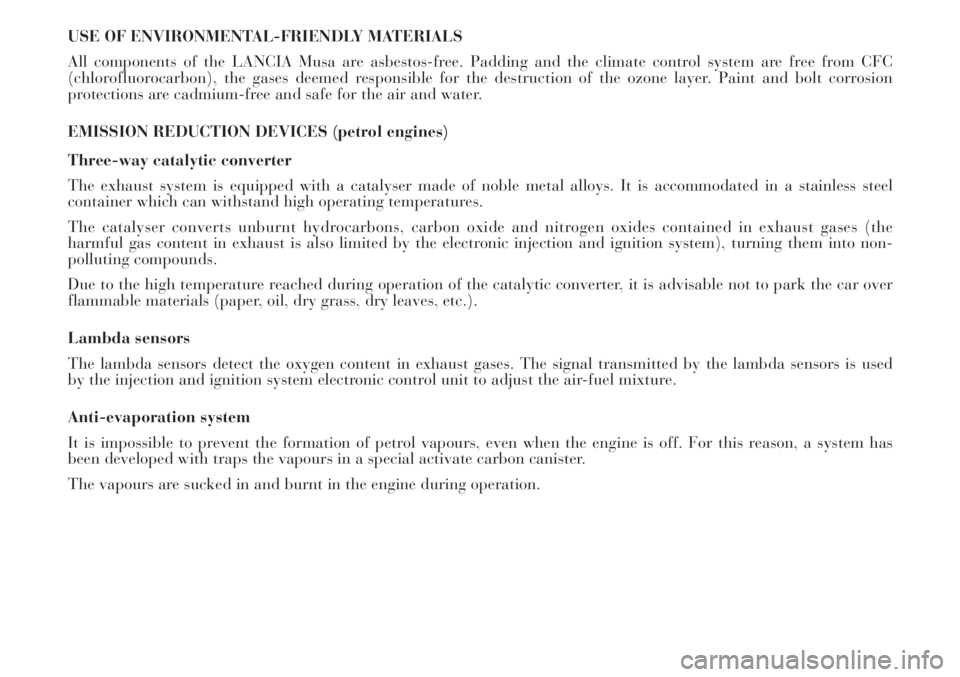
USE OF ENVIRONMENTAL-FRIENDLY MATERIALS
All components of the LANCIA Musa are asbestos-free. Padding and the climate control system are free from CFC
(chlorofluorocarbon), the gases deemed responsible for the destruction of the ozone layer. Paint and bolt corrosion
protections are cadmium-free and safe for the air and water.
EMISSION REDUCTION DEVICES (petrol engines)
Three-way catalytic converter
The exhaust system is equipped with a catalyser made of noble metal alloys. It is accommodated in a stainless steel
container which can withstand high operating temperatures.
The catalyser converts unburnt hydrocarbons, carbon oxide and nitrogen oxides contained in exhaust gases (the
harmful gas content in exhaust is also limited by the electronic injection and ignition system), turning them into non-
polluting compounds.
Due to the high temperature reached during operation of the catalytic converter, it is advisable not to park the car over
flammable materials (paper, oil, dry grass, dry leaves, etc.).
Lambda sensors
The lambda sensors detect the oxygen content in exhaust gases. The signal transmitted by the lambda sensors is used
by the injection and ignition system electronic control unit to adjust the air-fuel mixture.
Anti-evaporation system
It is impossible to prevent the formation of petrol vapours, even when the engine is off. For this reason, a system has
been developed with traps the vapours in a special activate carbon canister.
The vapours are sucked in and burnt in the engine during operation.
Page 8 of 218
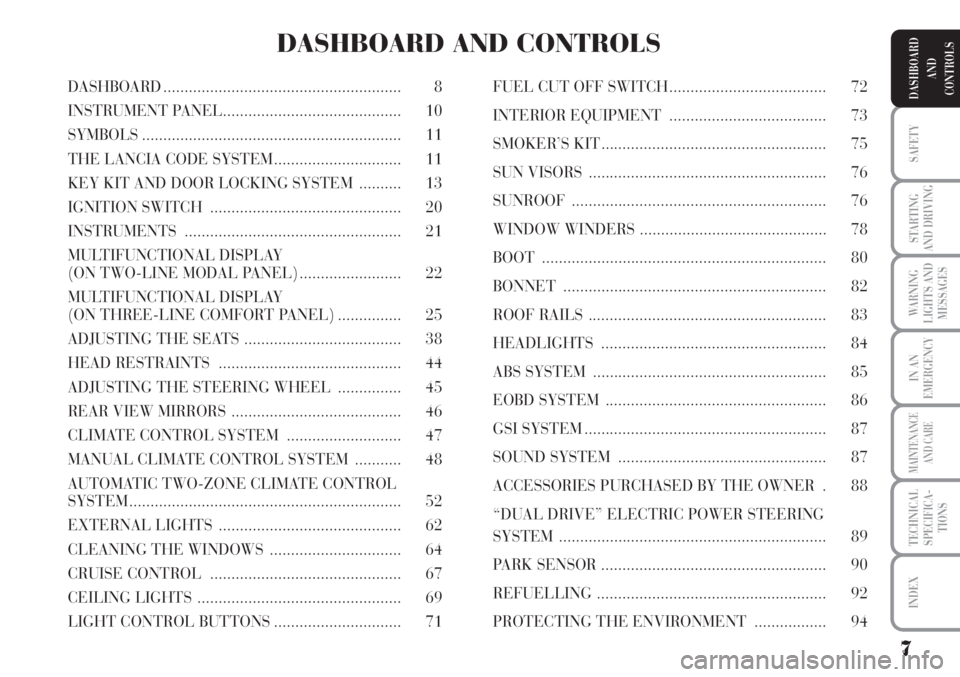
7
SAFETY
STARTING
AND DRIVING
WARNING
LIGHTS AND
MESSAGES
IN AN
EMERGENCY
MAINTENANCE
AND CARE
TECHNICAL
SPECIFICA-
TIONS
INDEX
DASHBOARD
AND
CONTROLSDASHBOARD ........................................................ 8
INSTRUMENT PANEL.......................................... 10
SYMBOLS ............................................................. 11
THE LANCIA CODE SYSTEM .............................. 11
KEY KIT AND DOOR LOCKING SYSTEM .......... 13
IGNITION SWITCH ............................................. 20
INSTRUMENTS ................................................... 21
MULTIFUNCTIONAL DISPLAY
(ON TWO-LINE MODAL PANEL) ........................ 22
MULTIFUNCTIONAL DISPLAY
(ON THREE-LINE COMFORT PANEL) ............... 25
ADJUSTING THE SEATS ..................................... 38
HEAD RESTRAINTS ........................................... 44
ADJUSTING THE STEERING WHEEL ............... 45
REAR VIEW MIRRORS ........................................ 46
CLIMATE CONTROL SYSTEM ........................... 47
MANUAL CLIMATE CONTROL SYSTEM ........... 48
AUTOMATIC TWO-ZONE CLIMATE CONTROL
SYSTEM ................................................................ 52
EXTERNAL LIGHTS ........................................... 62
CLEANING THE WINDOWS ............................... 64
CRUISE CONTROL ............................................. 67
CEILING LIGHTS ................................................ 69
LIGHT CONTROL BUTTONS .............................. 71FUEL CUT OFF SWITCH ..................................... 72
INTERIOR EQUIPMENT ..................................... 73
SMOKER’S KIT ..................................................... 75
SUN VISORS ........................................................ 76
SUNROOF ............................................................ 76
WINDOW WINDERS ............................................ 78
BOOT ................................................................... 80
BONNET .............................................................. 82
ROOF RAILS ........................................................ 83
HEADLIGHTS ..................................................... 84
ABS SYSTEM ....................................................... 85
EOBD SYSTEM .................................................... 86
GSI SYSTEM ......................................................... 87
SOUND SYSTEM ................................................. 87
ACCESSORIES PURCHASED BY THE OWNER . 88
“DUAL DRIVE” ELECTRIC POWER STEERING
SYSTEM ............................................................... 89
PARK SENSOR ..................................................... 90
REFUELLING ...................................................... 92
PROTECTING THE ENVIRONMENT ................. 94
DASHBOARD AND CONTROLS
Page 27 of 218
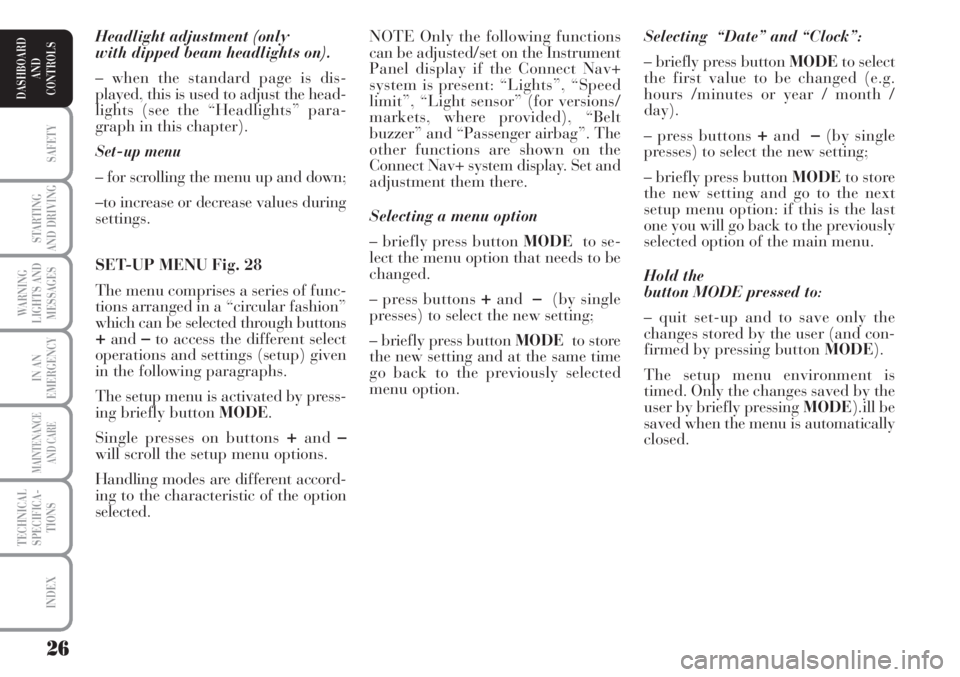
26
SAFETY
STARTING
AND DRIVING
WARNING
LIGHTS AND
MESSAGES
IN AN
EMERGENCY
MAINTENANCE
AND CARE
TECHNICAL
SPECIFICA-
TIONS
INDEX
DASHBOARD
AND
CONTROLS
Headlight adjustment (only
with dipped beam headlights on).
– when the standard page is dis-
played, this is used to adjust the head-
lights (see the “Headlights” para-
graph in this chapter).
Set-up menu
– for scrolling the menu up and down;
–to increase or decrease values during
settings.
SET-UP MENU Fig. 28
The menu comprises a series of func-
tions arranged in a “circular fashion”
which can be selected through buttons
+and–to access the different select
operations and settings (setup) given
in the following paragraphs.
The setup menu is activated by press-
ing briefly button MODE.
Single presses on buttons
+and–will scroll the setup menu options.
Handling modes are different accord-
ing to the characteristic of the option
selected.Selecting “Date” and “Clock”:
– briefly press button MODEto select
the first value to be changed (e.g.
hours /minutes or year / month /
day).
– press buttons
+and–(by single
presses) to select the new setting;
– briefly press button MODEto store
the new setting and go to the next
setup menu option: if this is the last
one you will go back to the previously
selected option of the main menu.
Hold the
button MODE pressed to:
– quit set-up and to save only the
changes stored by the user (and con-
firmed by pressing button MODE).
The setup menu environment is
timed. Only the changes saved by the
user by briefly pressing MODE).ill be
saved when the menu is automatically
closed. NOTE Only the following functions
can be adjusted/set on the Instrument
Panel display if the Connect Nav+
system is present: “Lights”, “Speed
limit”, “Light sensor” (for versions/
markets, where provided), “Belt
buzzer” and “Passenger airbag”. The
other functions are shown on the
Connect Nav+ system display. Set and
adjustment them there.
Selecting a menu option
– briefly press button MODEto se-
lect the menu option that needs to be
changed.
– press buttons
+and–(by single
presses) to select the new setting;
– briefly press button MODEto store
the new setting and at the same time
go back to the previously selected
menu option.
Page 28 of 218
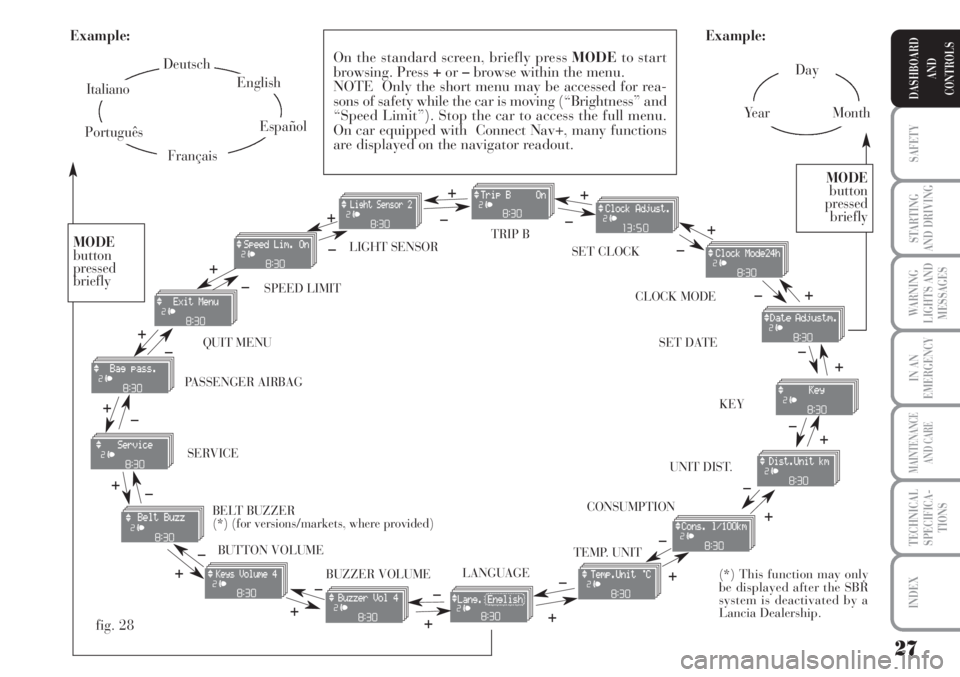
27
SAFETY
STARTING
AND DRIVING
WARNING
LIGHTS AND
MESSAGES
IN AN
EMERGENCY
MAINTENANCE
AND CARE
TECHNICAL
SPECIFICA-
TIONS
INDEX
DASHBOARD
AND
CONTROLS
Day
Ye a rMonth Example:
CONSUMPTION QUIT MENU SPEED LIMIT SET CLOCK LIGHT SENSOR TRIP B
CLOCK MODE
SET DATE
KEY
UNIT DIST.
BUTTON VOLUME
BUZZER VOLUME SERVICE
LANGUAGETEMP. UNIT
Example:
– +
+– – –
+ +
–
–
+
+++
–––
+ +
–
MODE
button
pressed
briefly
On the standard screen, briefly press MODEto start
browsing. Press +or–browse within the menu.
NOTE Only the short menu may be accessed for rea-
sons of safety while the car is moving (“Brightness” and
“Speed Limit”). Stop the car to access the full menu.
On car equipped with Connect Nav+, many functions
are displayed on the navigator readout.
–
+ +
–
MODE
button
pressed
briefly
Deutsch
English
Español
Italiano
Português
Français
(*) This function may only
be displayed after the SBR
system is deactivated by a
Lancia Dealership.
fig. 28
+
– +
–+
–
+
–
+ –
BELT BUZZER
(*) (for versions/markets, where provided) PASSENGER AIRBAG
Page 30 of 218
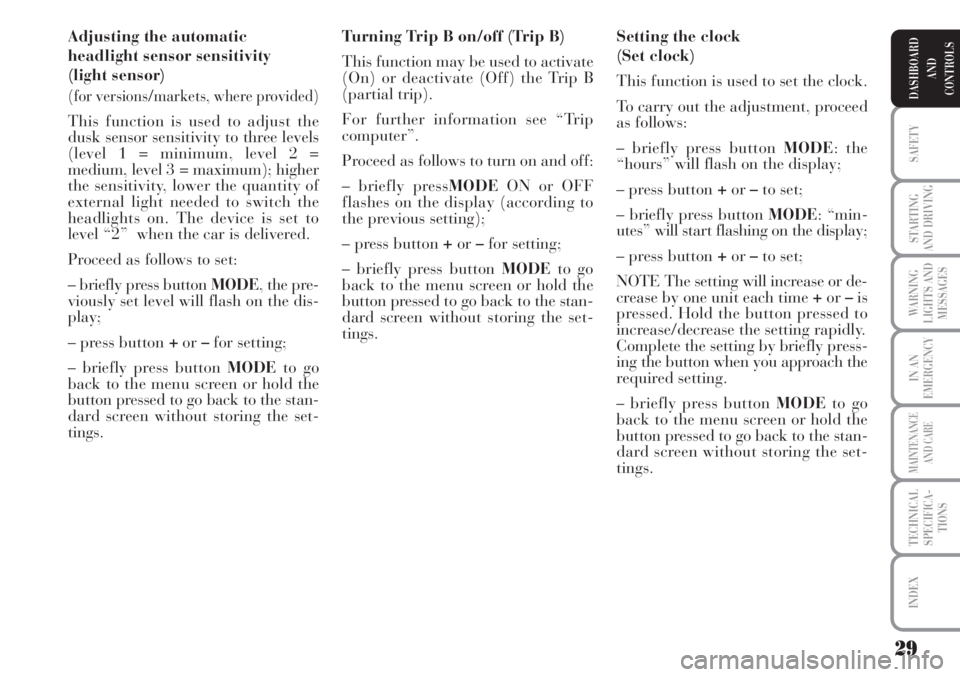
29
SAFETY
STARTING
AND DRIVING
WARNING
LIGHTS AND
MESSAGES
IN AN
EMERGENCY
MAINTENANCE
AND CARE
TECHNICAL
SPECIFICA-
TIONS
INDEX
DASHBOARD
AND
CONTROLS
Adjusting the automatic
headlight sensor sensitivity
(light sensor)
(for versions/markets, where provided)
This function is used to adjust the
dusk sensor sensitivity to three levels
(level 1 = minimum, level 2 =
medium, level 3 = maximum); higher
the sensitivity, lower the quantity of
external light needed to switch the
headlights on. The device is set to
level “2” when the car is delivered.
Proceed as follows to set:
– briefly press button MODE, the pre-
viously set level will flash on the dis-
play;
– press button +or–for setting;
– briefly press button MODEto go
back to the menu screen or hold the
button pressed to go back to the stan-
dard screen without storing the set-
tings.Turning Trip B on/off (Trip B)
This function may be used to activate
(On) or deactivate (Off) the Trip B
(partial trip).
For further information see “Trip
computer”.
Proceed as follows to turn on and off:
– briefly pressMODEON or OFF
flashes on the display (according to
the previous setting);
– press button +or–for setting;
– briefly press button MODEto go
back to the menu screen or hold the
button pressed to go back to the stan-
dard screen without storing the set-
tings.Setting the clock
(Set clock)
This function is used to set the clock.
To carry out the adjustment, proceed
as follows:
– briefly press button MODE: the
“hours” will flash on the display;
– press button +or–to set;
– briefly press button MODE: “min-
utes” will start flashing on the display;
– press button +or–to set;
NOTE The setting will increase or de-
crease by one unit each time +or–is
pressed. Hold the button pressed to
increase/decrease the setting rapidly.
Complete the setting by briefly press-
ing the button when you approach the
required setting.
– briefly press button MODEto go
back to the menu screen or hold the
button pressed to go back to the stan-
dard screen without storing the set-
tings.
Page 53 of 218
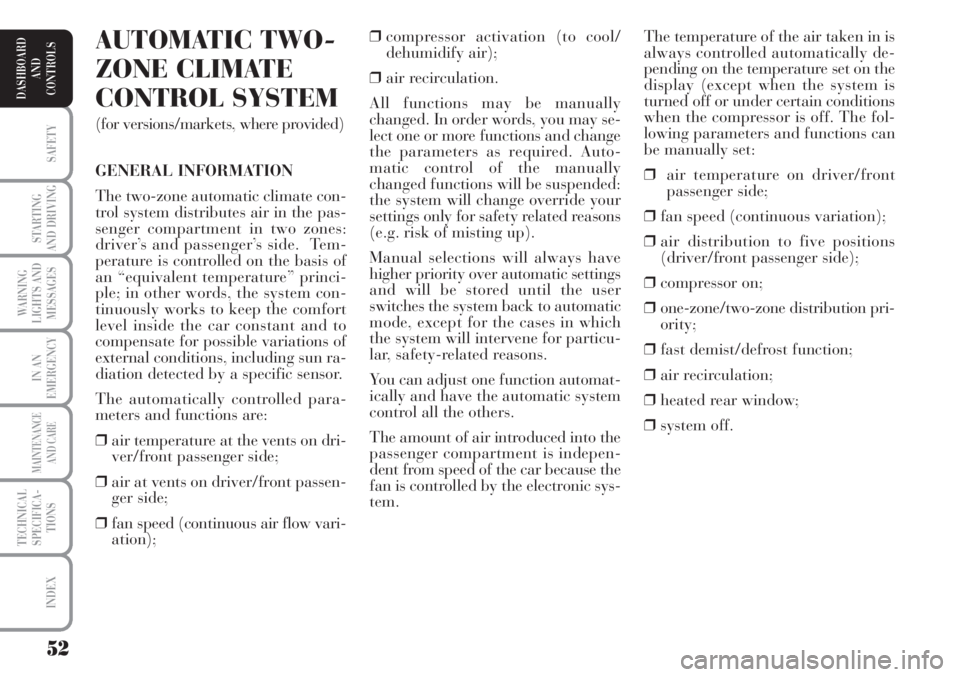
52
SAFETY
STARTING
AND DRIVING
WARNING
LIGHTS AND
MESSAGES
IN AN
EMERGENCY
MAINTENANCE
AND CARE
TECHNICAL
SPECIFICA-
TIONS
INDEX
DASHBOARD
AND
CONTROLS
The temperature of the air taken in is
always controlled automatically de-
pending on the temperature set on the
display (except when the system is
turned off or under certain conditions
when the compressor is off. The fol-
lowing parameters and functions can
be manually set:
❒air temperature on driver/front
passenger side;
❒fan speed (continuous variation);
❒air distribution to five positions
(driver/front passenger side);
❒compressor on;
❒one-zone/two-zone distribution pri-
ority;
❒fast demist/defrost function;
❒air recirculation;
❒heated rear window;
❒system off. ❒compressor activation (to cool/
dehumidify air);
❒air recirculation.
All functions may be manually
changed. In order words, you may se-
lect one or more functions and change
the parameters as required. Auto-
matic control of the manually
changed functions will be suspended:
the system will change override your
settings only for safety related reasons
(e.g. risk of misting up).
Manual selections will always have
higher priority over automatic settings
and will be stored until the user
switches the system back to automatic
mode, except for the cases in which
the system will intervene for particu-
lar, safety-related reasons.
You can adjust one function automat-
ically and have the automatic system
control all the others.
The amount of air introduced into the
passenger compartment is indepen-
dent from speed of the car because the
fan is controlled by the electronic sys-
tem.AUTOMATIC TWO-
ZONE CLIMATE
CONTROL SYSTEM
(for versions/markets, where provided)
GENERAL INFORMATION
The two-zone automatic climate con-
trol system distributes air in the pas-
senger compartment in two zones:
driver’s and passenger’s side. Tem-
perature is controlled on the basis of
an “equivalent temperature” princi-
ple; in other words, the system con-
tinuously works to keep the comfort
level inside the car constant and to
compensate for possible variations of
external conditions, including sun ra-
diation detected by a specific sensor.
The automatically controlled para-
meters and functions are:
❒air temperature at the vents on dri-
ver/front passenger side;
❒air at vents on driver/front passen-
ger side;
❒fan speed (continuous air flow vari-
ation);
Page 64 of 218
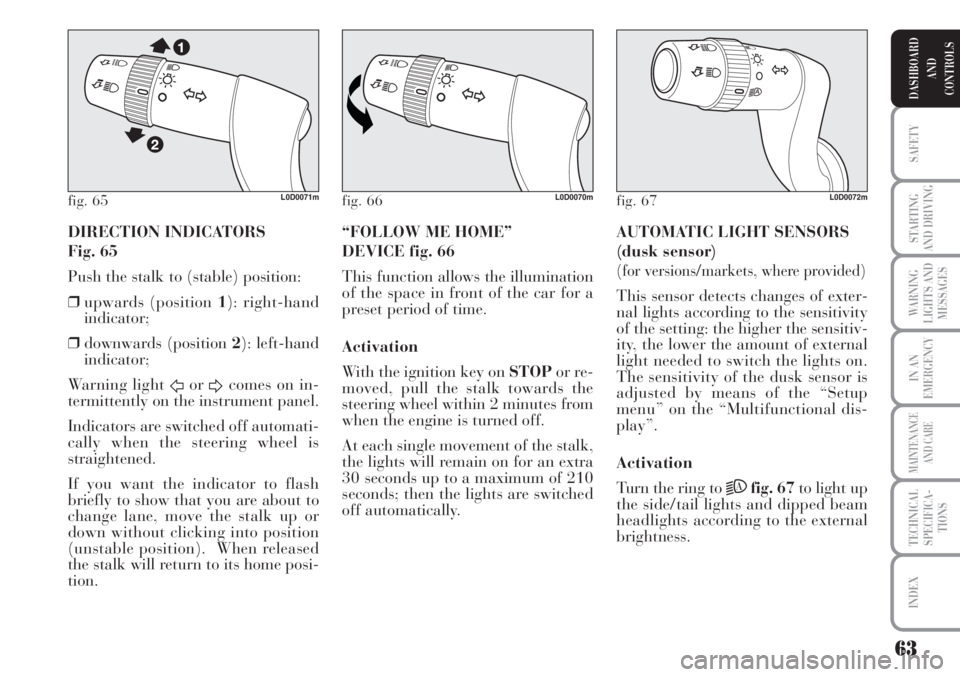
63
SAFETY
STARTING
AND DRIVING
WARNING
LIGHTS AND
MESSAGES
IN AN
EMERGENCY
MAINTENANCE
AND CARE
TECHNICAL
SPECIFICA-
TIONS
INDEX
DASHBOARD
AND
CONTROLS
DIRECTION INDICATORS
Fig. 65
Push the stalk to (stable) position:
❒upwards (position 1): right-hand
indicator;
❒downwards (position 2): left-hand
indicator;
Warning light
ForDcomes on in-
termittently on the instrument panel.
Indicators are switched off automati-
cally when the steering wheel is
straightened.
If you want the indicator to flash
briefly to show that you are about to
change lane, move the stalk up or
down without clicking into position
(unstable position). When released
the stalk will return to its home posi-
tion.AUTOMATIC LIGHT SENSORS
(dusk sensor)
(for versions/markets, where provided)
This sensor detects changes of exter-
nal lights according to the sensitivity
of the setting: the higher the sensitiv-
ity, the lower the amount of external
light needed to switch the lights on.
The sensitivity of the dusk sensor is
adjusted by means of the “Setup
menu” on the “Multifunctional dis-
play”.
Activation
Turn the ring to
2Afig. 67to light up
the side/tail lights and dipped beam
headlights according to the external
brightness. “FOLLOW ME HOME”
DEVICE fig. 66
This function allows the illumination
of the space in front of the car for a
preset period of time.
Activation
With the ignition key on STOPor re-
moved, pull the stalk towards the
steering wheel within 2 minutes from
when the engine is turned off.
At each single movement of the stalk,
the lights will remain on for an extra
30 seconds up to a maximum of 210
seconds; then the lights are switched
off automatically.
fig. 65L0D0071mfig. 66L0D0070mfig. 67L0D0072m
Page 65 of 218
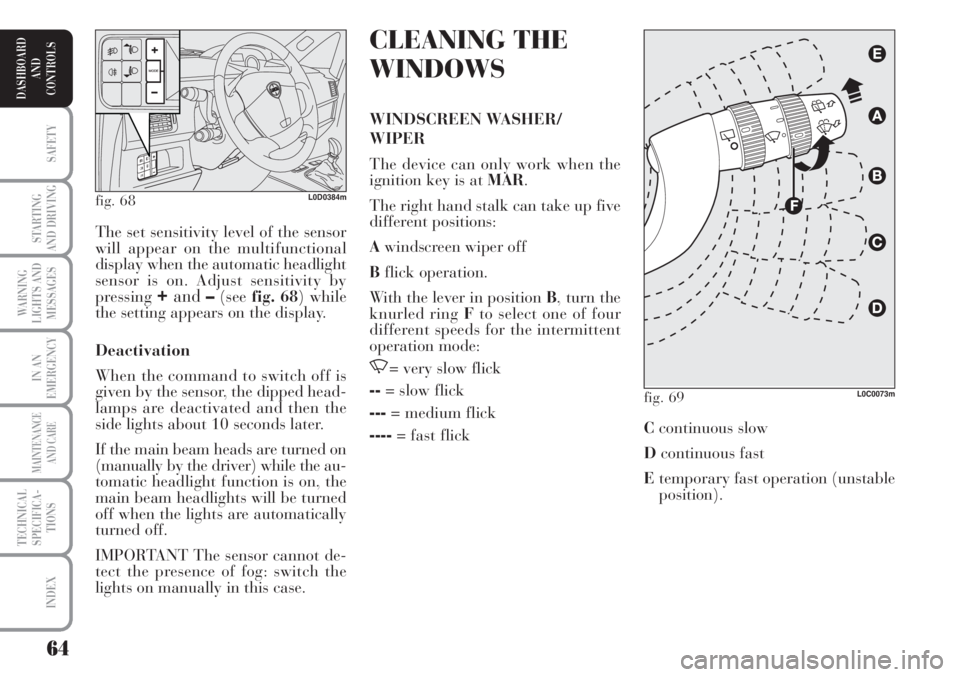
64
SAFETY
STARTING
AND DRIVING
WARNING
LIGHTS AND
MESSAGES
IN AN
EMERGENCY
MAINTENANCE
AND CARE
TECHNICAL
SPECIFICA-
TIONS
INDEX
DASHBOARD
AND
CONTROLS
CLEANING THE
WINDOWS
WINDSCREEN WASHER/
WIPER
The device can only work when the
ignition key is at MAR.
The right hand stalk can take up five
different positions:
Awindscreen wiper off
Bflick operation.
With the lever in position B, turn the
knurled ring Fto select one of four
different speeds for the intermittent
operation mode:
,= very slow flick
--= slow flick
---= medium flick
----= fast flick The set sensitivity level of the sensor
will appear on the multifunctional
display when the automatic headlight
sensor is on. Adjust sensitivity by
pressing
+and–(seefig. 68) while
the setting appears on the display.
Deactivation
When the command to switch off is
given by the sensor, the dipped head-
lamps are deactivated and then the
side lights about 10 seconds later.
If the main beam heads are turned on
(manually by the driver) while the au-
tomatic headlight function is on, the
main beam headlights will be turned
off when the lights are automatically
turned off.
IMPORTANT The sensor cannot de-
tect the presence of fog: switch the
lights on manually in this case.
fig. 68L0D0384m
fig. 69L0C0073m
Ccontinuous slow
Dcontinuous fast
Etemporary fast operation (unstable
position).
Page 66 of 218
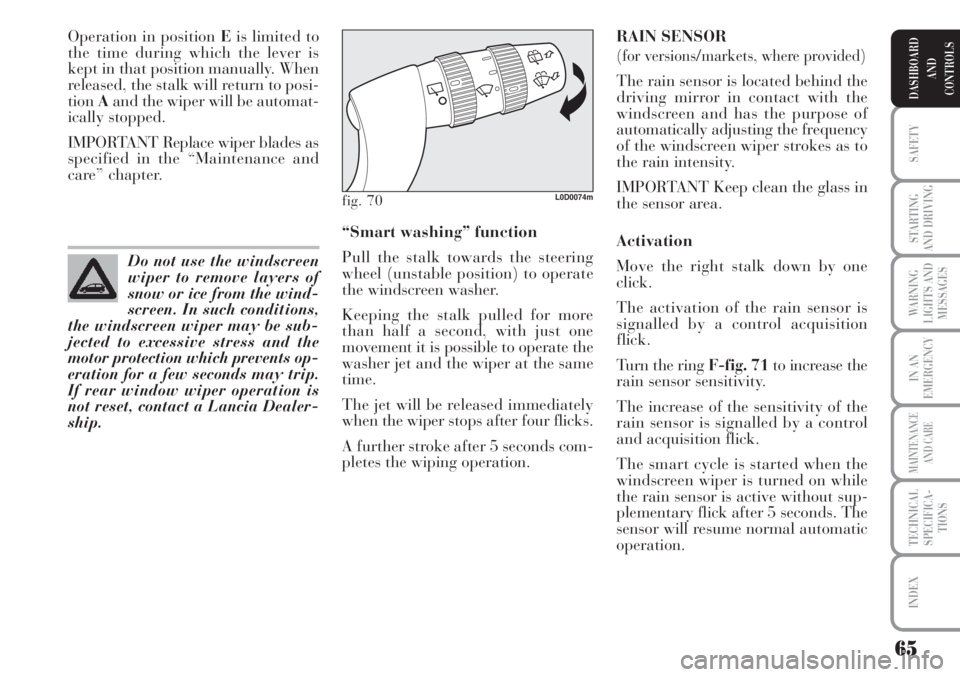
65
SAFETY
STARTING
AND DRIVING
WARNING
LIGHTS AND
MESSAGES
IN AN
EMERGENCY
MAINTENANCE
AND CARE
TECHNICAL
SPECIFICA-
TIONS
INDEX
DASHBOARD
AND
CONTROLS
Operation in position Eis limited to
the time during which the lever is
kept in that position manually. When
released, the stalk will return to posi-
tionAand the wiper will be automat-
ically stopped.
IMPORTANT Replace wiper blades as
specified in the “Maintenance and
care” chapter. RAIN SENSOR
(for versions/markets, where provided)
The rain sensor is located behind the
driving mirror in contact with the
windscreen and has the purpose of
automatically adjusting the frequency
of the windscreen wiper strokes as to
the rain intensity.
IMPORTANT Keep clean the glass in
the sensor area.
Activation
Move the right stalk down by one
click.
The activation of the rain sensor is
signalled by a control acquisition
flick.
Turn the ring F-fig. 71to increase the
rain sensor sensitivity.
The increase of the sensitivity of the
rain sensor is signalled by a control
and acquisition flick.
The smart cycle is started when the
windscreen wiper is turned on while
the rain sensor is active without sup-
plementary flick after 5 seconds. The
sensor will resume normal automatic
operation. “Smart washing” function
Pull the stalk towards the steering
wheel (unstable position) to operate
the windscreen washer.
Keeping the stalk pulled for more
than half a second, with just one
movement it is possible to operate the
washer jet and the wiper at the same
time.
The jet will be released immediately
when the wiper stops after four flicks.
A further stroke after 5 seconds com-
pletes the wiping operation. Do not use the windscreen
wiper to remove layers of
snow or ice from the wind-
screen. In such conditions,
the windscreen wiper may be sub-
jected to excessive stress and the
motor protection which prevents op-
eration for a few seconds may trip.
If rear window wiper operation is
not reset, contact a Lancia Dealer-
ship.
fig. 70L0D0074m
Page 67 of 218
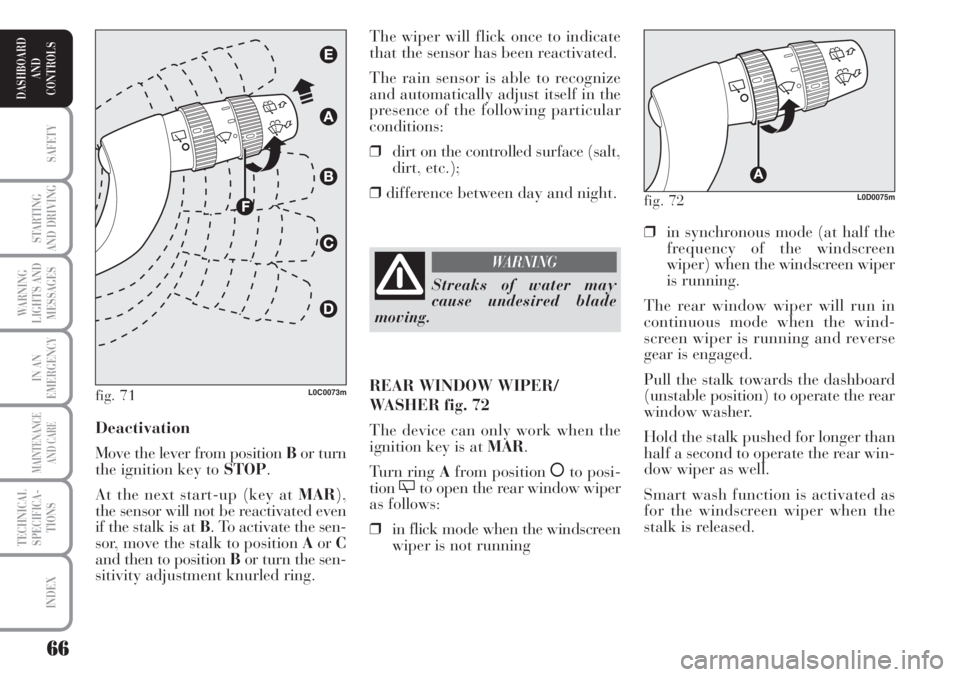
66
SAFETY
STARTING
AND DRIVING
WARNING
LIGHTS AND
MESSAGES
IN AN
EMERGENCY
MAINTENANCE
AND CARE
TECHNICAL
SPECIFICA-
TIONS
INDEX
DASHBOARD
AND
CONTROLS
❒in synchronous mode (at half the
frequency of the windscreen
wiper) when the windscreen wiper
is running.
The rear window wiper will run in
continuous mode when the wind-
screen wiper is running and reverse
gear is engaged.
Pull the stalk towards the dashboard
(unstable position) to operate the rear
window washer.
Hold the stalk pushed for longer than
half a second to operate the rear win-
dow wiper as well.
Smart wash function is activated as
for the windscreen wiper when the
stalk is released. The wiper will flick once to indicate
that the sensor has been reactivated.
The rain sensor is able to recognize
and automatically adjust itself in the
presence of the following particular
conditions:
❒dirt on the controlled surface (salt,
dirt, etc.);
❒difference between day and night.
Deactivation
Move the lever from position Bor turn
the ignition key to STOP.
At the next start-up (key at MAR),
the sensor will not be reactivated even
if the stalk is at B. To activate the sen-
sor, move the stalk to position AorC
and then to position Bor turn the sen-
sitivity adjustment knurled ring.
fig. 71L0C0073m
Streaks of water may
cause undesired blade
moving.
WARNING
REAR WINDOW WIPER/
WASHER fig. 72
The device can only work when the
ignition key is at MAR.
Turn ring Afrom position
åto posi-
tion'to open the rear window wiper
as follows:
❒in flick mode when the windscreen
wiper is not running
fig. 72L0D0075m